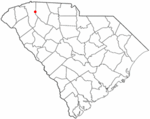Greenville–Spartanburg International Airport
1962 establishments in South CarolinaAirports established in 1962Airports in South CarolinaBuildings and structures in Greenville County, South CarolinaBuildings and structures in Spartanburg County, South Carolina ... and 2 more
Transportation in Greenville, South CarolinaUse mdy dates from May 2014

Greenville–Spartanburg International Airport (Roger Milliken Field, IATA: GSP, ICAO: KGSP, FAA LID: GSP) is near Greer, South Carolina, United States, midway between Greenville and Spartanburg, the major cities of the Upstate region. The airport is the third-busiest airport in South Carolina, after Charleston International Airport, and Myrtle Beach International Airport with over 2.56 million passengers in 2023. The Federal Aviation Administration (FAA) National Plan of Integrated Airport Systems for 2017–2021 categorized it as a small-hub primary commercial service facility.
Excerpt from the Wikipedia article Greenville–Spartanburg International Airport (License: CC BY-SA 3.0, Authors, Images).Greenville–Spartanburg International Airport
GSP Drive, Greer
Geographical coordinates (GPS) Address Phone number Website External links Nearby Places Show on map
Geographical coordinates (GPS)
| Latitude | Longitude |
|---|---|
| N 34.895555555556 ° | E -82.218888888889 ° |
Address
Greenville-Spartanburg International Airport (GSP International Airport)
GSP Drive 2000
29651 Greer
South Carolina, United States
Open on Google Maps










